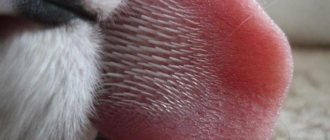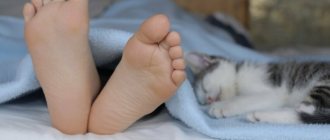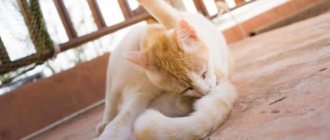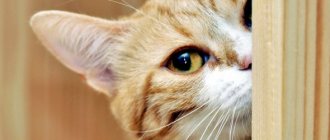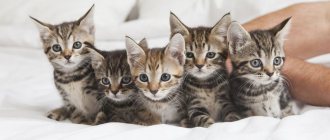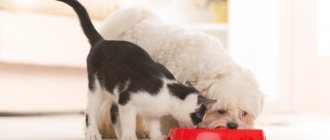Play, hormone!
One of the safest reasons that provokes a dilated pupil in a cat is high hormonal activity. During the rutting period, not only the physiological indicators of tailed animals change dramatically, but also their habits. Can't understand why your cat's pupils are dilated? Take a closer look at her behavior.
During the period of heat, the cat behaves so eloquently that it is simply impossible not to notice it:
- crawling on the floor on your stomach;
- loud inviting meow;
- purring and “wiping” all protruding parts of the furniture;
- frequent visits to the litter box;
- the animal's tail is constantly thrown up and to the side;
- pussy licks genitals all the time;
- many switch to breathing through their mouths, leaving their nose free to sniff out their prospective girlfriend.
Reviews from owners eloquently indicate that during this period, owners simply do not have time to think about why the cat has dilated pupils. They are more concerned about the urgent search for a “groom” for their pet or rush around in search of drugs that reduce sexual activity.
How to find out if a cat can see?
Given the high adaptability of cats, problems with vision, which is lost gradually, can be identified at fairly advanced stages. The pet becomes less mobile, sleeps more, prefers to move exclusively on floor surfaces, which does not cause much concern for the owners. Blindness in a cat can be determined by a number of the following signs:
- Refusal to jump.
- Careful movement around the home.
- It is difficult for a cat to control the sequence of steps; while walking, the animal stumbles into an amble and stops.
- A large number of broken whiskers are observed. With complete or partial loss of vision, the cat “feels the world” and picks up air vibrations with its whiskers.
- There is no reflection of the eyes in the dark, but in the light, the gaze is deconcentrated.
- The animal crashes into objects that are not in their “usual” place.
The characteristics of the cat's central nervous system explain a number of nuances that can be mistaken for vision loss if the pet cannot see.
Cats can lose their vision for a variety of reasons. Vision often weakens with age, but due to injury or disease, even a kitten can go blind. What to do if your cat is blind?
How to help?
Firstly, you need to take a healthy approach to the situation. You should not try on the loss of vision on yourself and transfer the terrible human experiences about this to your cat. Cats themselves are unlikely to be prone to getting emotional and causing tragedy; blind domestic cats can lead a normal life and feel happy
. A blind cat needs help, but not pity.
Secondly, you should definitely consult a good veterinarian. The doctor will be able to correctly diagnose, prescribe the necessary treatment and advise special care for a blind cat. What if, under certain conditions, vision can be restored? Or maybe the loss of vision is partial, and proper care will prevent complete blindness? In any case, a blind cat should be regularly shown to a veterinarian to monitor its eyes and general health.
Thirdly, it depends mainly on the owners themselves how comfortable and fulfilling their pet’s life will be day after day.
1. Cats who have lost their sight rely heavily on their memory.
.
If a cat loses its vision gradually, it may behave as usual within the confines of a familiar home. Owners notice something is wrong after repairs or rearrangements, when their pet suddenly starts bumping into everything. stability
in your home . Do not rearrange the furniture, and if you rearranged it, for example, when guests arrived, return everything back. Bowls with water and food, the tray must be in one place! If the premises are new, you need to patiently accustom the cat to each place by placing the cat near them (directly in the litter box in the case of a litter box) and allowing the cat to find its way from these most significant non-objects to other parts of its domain.
2. Make the environment safe
– remove all sharp objects, wrap treacherous corners with soft material, block open staircases and fireplaces, and exits to the balcony. Do not leave boxes, shoes, umbrellas, toys, etc. scattered on the floor. – now it’s not only a matter of order, but also of convenient movement of the cat around the house.
3. Home is the safest place for a cat that has lost its sight. It is highly recommended not to release it into the outside world! But if the cat is used to walking on the grass, basking in the sun and continues to persistently ask for a breath of fresh air, it is not necessary to deprive her of this pleasure. Only now on walks
She must be accompanied, if trained, to be walked on a leash. Under no circumstances should you leave her alone on the street - except in her own courtyard, closed from external dangers, where the cat is familiar with everything, and caring owners have removed or securely covered all dangerous objects, pits, pools, etc. If there is a possibility that a blind cat will end up on the street, then on the collar it is worth indicating not only the coordinates of the owners, but also information that the cat cannot see.
4. In cats that have lost their sight, other senses become more acute - smell, hearing
. This is worth using to help your cat navigate. For example, you can “mark” rooms with different subtle scents so that your cat always knows where he is. Strong and unpleasant odors should be avoided!
5. Talk to your cat!
In this case, it is not a quirk, but a necessity; it makes her feel safe and calms her down. She hears that someone has entered the room - say something to her, let her know that it is you! Talk to her before petting or picking her up, otherwise she may get scared out of surprise, not accept affection, and even bite or scratch. A blind cat can become very affectionate. Constantly follow the owner, using him as a guide. In this case, inform your cat when you leave the room, making the task easier.
6. Avoid sharp, incomprehensible, frightening sounds
. If something falls in the kitchen with an unimaginable crash, find the cat, pet it and calm it down.
7. If there are several animals in the house
, you can put on collars with trinkets to warn the cat of their approach with a characteristic sound. A blind cat may also rely on other cats to navigate around the house. Here is an amazing case of how a cat became a guide for a blind dog.
8. A blind cat is first and foremost a cat, so play with it.
. Rustling, mouse-like squeaking, buzzing, tinkling things are suitable as toys. The cat will love to follow the sound. When hunting, even playfully, a cat feels like a cat. Help her with this!
In Gwen Cooper's book "Homer's Odyssey"
tells the true story of a blind kitten who not only lives a full life as a cat (moves freely around the house, is friends with two other cats and catches flies better than them), but also became a real superhero.
So, he stopped a burglar who broke into the house, inspired her to write a book and helped the owner meet the man of her dreams. — Recommended reading!
Especially for the site, Maxim Naumov
Pictured is Gwen Cooper with her cat Homer
So, you are planning to buy a disabled cat or have already purchased one. If this is your thoughtful decision, my applause! Know that you really helped a living being. Disabled animals have the least chance of finding their home. If you acquired such a cat by mistake or by accident, then I beg you: do not throw it out onto the street! In outdoor conditions (among violent people, packs of dogs and crazy traffic), the likelihood that a blind or deaf animal will survive is minimal.
Of course, caring for a blind cat will be unique, but still not particularly difficult. The behavior of a blind animal will also differ from that of a healthy cat. I will talk about this below.
What diseases can cause a cat to go blind? Eye injuries, congenital defects, conjunctival diseases, tumors, glaucoma, cataracts, hyperthyroidism, dry eye syndrome.
Consequences of stress
A dilated pupil in a cat can cause deep distress. This phenomenon can be especially often noticed in cats that have just moved into a new apartment, have not yet explored the situation and are expecting an attack from literally around every corner.
An animal’s worries can be caused by the appearance of a new pet in the house: a puppy, a cat, or someone else. The pussy will be under stress for a long time, fighting for its territory and the attention of its owners.
The real horror for most cats, especially young ones, is the process of bathing. After this, many cats cannot calm down for a long time. Hence the “big” eyes.
Surely every owner has seen the huge eyes of their cat the moment they turn on the vacuum cleaner, blender or other household appliances. The cat does not understand the design of the unit and is trying to figure out where the sound is coming from, why it is dangerous and why it is so loud and sudden. Over time, many purrs get used to extraneous sounds and react less fearfully.
Pupils of prey
The exact opposite of the vertical pupils of hunters are the horizontal pupils of those who could become their prey. Rectangular horizontal pupils can be observed in goats, sheep, horses and even frogs. Research has shown that out of 42 observed herbivores, 26 had horizontal pupils. As a result, it became clear that such pupils make it possible to minimize the image above and below, but make it as wide as possible. Moreover, it is worth noting that in most of these animals the pupils are located on the sides of the head, which gives them an almost panoramic view. This allows the animals to keep an eye on what is happening on their sides and behind, and it also protects their eyes from sunlight from above. In addition, such pupils minimize blur and make vision much clearer overall, so that the animal can spot a predator anywhere around it at any time.
Sugar cookies in the shape of a rainbow: we delight loved ones with a colorful delicacy
Packing the necessary things for traveling this summer: tips for tourists
June 29 – Tikhon: you need to collect herbs and weed the beds (signs and beliefs)
Storm in a bowl of milk
In a calm state, cat eyes are of normal size, and the pupils are more like narrow slits. A cat's dilated pupil appears during evening runs along the ceiling and walls. During this period, the angry animal receives a powerful surge of adrenaline, and its eyes turn into huge “tea saucers.” At this moment, pupil enlargement also has a purely practical function. By performing masterly jumps and somersaults, the cat orients itself better in space and sees the outlines of objects more clearly. The dilated pupils at this moment help her not to hurt herself or get hurt.
You can also notice a dilated pupil in a cat when she is hunting. The pet concentrates its attention and hopes that a mouse is about to appear around the corner.
It is absolutely clear that such manifestations do not require treatment at all. The owners can rest easy. When the storm in a glass of water subsides and the tension subsides, the cat's pupils will return to normal size.
What treatment is prescribed?
After the animal recovers from the stressful state, its pupils will become the same size.
In normal conditions, in daylight, a cat has narrow pupils. Due to an irritating factor, for example, stress, nervous overexcitation, they are expanded. But when the animal calms down, the pupils themselves become narrowed, so treatment in such situations is not required. If the large size of the pupils is a consequence of any internal pathology, medications are prescribed to eliminate it. When the root cause can be cured, it will become noticeable that the pupils have narrowed and acquired a normal shape. The following groups of drugs are often prescribed to treat the disorder:
- glucocorticosteroids;
- diuretics;
- painkillers;
- normalizing blood pressure;
- antifungal;
- antibiotics;
- immunostimulants, vitamins.
If one pupil is narrowed and the other is dilated due to retinal detachment, conservative methods are often powerless. In this case, the doctor decides to perform a surgical operation called pneumatic retinopexy.
My clear light
The eyes of a cat, like any living creature, react to light. In bright light they narrow, and in dim light they expand. If a cat has constantly dilated pupils, the owners need to start worrying. Your pet may have decreased visual acuity. A veterinarian will help determine the cause. With eye diseases, the pupil's sensitivity to light gradually decreases, so even in very bright light, a cat's pupils may remain dilated.
It makes sense to listen to the feedback of specialists and experienced animal owners. Delay may result in your pet becoming completely blind. Even without a doctor, you can determine which eye is affected by the disease. The damaged pupil will remain dilated at all times, regardless of changes in the lighting situation.
When dilated pupils in a cat are a sign of normality
Times of Day
At night, cats' pupils are always dilated, regardless of their internal state - this is an adaptive reaction that helps them see better and more clearly in the dark. These animals are able to capture even the light of stars, using it to correct their visual abilities.
Estrus
If, during the period of heat, a cat constantly exhibits dilated pupils, this is considered normal. This is the body’s reaction to all sorts of hormonal changes that occur at this time in the animal’s body. During this period, dilated pupils are accompanied by classic signs of the sexual cycle - loud meowing and purring, pressing to the floor with the tail raised up, frequent urination and constant licking of the perineum. The condition goes away on its own after the end of estrus.
Internal discomfort, wariness
Fear, stress, overexcitation, and aggression are also always accompanied by prolonged dilation of the pupils, regardless of the influence of light. Cats see everything in slightly blurred outlines, and during periods of internal discomfort, they intuitively look around to consider sources of potential danger.
The pupils are affected by adrenaline, which is produced whenever the animal is in any excited state. Dissatisfaction, in addition to dilated pupils, may also be accompanied by hissing, the animal stands on its hind legs and presses its ears.
When a new cat is brought into the house, the “old” pet will react to the new resident with wariness and always look at him with dilated pupils. Everything returns to normal after the “neighbors” get used to each other. It is enough to take the cat in your arms or talk to it gently and stroke it to show that the pet is not in danger. It is enough for the cat to calm down for the pupils to “relax” and become dependent on light again.
Outdoor games, emotional outbursts, hunting
The cat's pupils are constantly dilated during active games, running, jumping or trying to catch a bird/mouse. Firstly, she needs to clearly see potential prey, as well as more clearly measure the different distances between objects in order to reduce the risk of injury. This is also a natural reaction to the production of active adrenaline. At the end of the games everything will return to normal.
Postoperative condition
For some time after anesthesia, cats retain dilated pupils that do not clearly react to light. After a maximum of 24 hours, the animal recovers from anesthesia, and the state of the pupils returns to normal.
Problems are hidden in the depths
If a cat's pupils are constantly dilated, this may indicate the presence of a disease not related to vision at all. Large round eyes can be evidence of the pain that the animal constantly experiences. Many pussies are real stoics: they meekly endure the pain of injuries, endure convulsions and spasms.
If the unhappy expression on the face and large round pupils are accompanied by constant lethargy of the animal, unnatural postures during sleep, refusal to eat, stiff gait or inactivity, the owners should sound the alarm. The cause could be anywhere: dislocation, infection, heart disease, stroke, internal bleeding and much more. Only an experienced doctor, having carried out all the necessary tests, will be able to tell exactly what is hurting your pet.
Nervous conditions
The cause of dilated pupils may be nervousness, depression, stress, or fear. Most often, this condition occurs in an animal when the usual environment changes. For example, when moving or when a pet unexpectedly ends up on the street. Dilated pupils mean that the cat is prepared to repel possible danger and will be on alert around the clock.
The appearance of unfamiliar people and animals at home leads to the same reaction. At the same time, the animal develops additional symptoms :
- stiffness of movements;
- ingratiation;
- careful step.
A cat may have large pupils during periods of severe stress. The most common cause is the weaning of kittens. Some cat breeds have very strong maternal instincts. Therefore, before selecting kittens, it is important to prepare the animal for this. Even special techniques have been developed.
Wide eyes may appear after joyful overexcitement. For example, when an animal wants to “go wild”, play, and begins a mad race throughout the apartment. In this way, it burns off excess accumulated adrenaline, and widened eyes allow you to orient yourself more accurately, avoid bumping into furniture, and avoid getting injured.
Another common cause is the smell of a dog or an encounter with one. They have not gotten along with cats for a long time and are potentially dangerous. As a result, she comes into “combat readiness.” The pupils dilate greatly and will remain so until the danger has passed. If a dog is taken into a home where there is a cat, its eyes may remain huge until it realizes that there is no threat.
Special eyes
If a cat has one pupil dilated and the other constricted, this may indicate anisocoria. This disease is precisely characterized by different pupil sizes. Moreover, depending on the reasons that cause it, the patient may have either an eye with a small pupil or a large one.
As a rule, anisocoria is only a symptom of another, more serious disease. Its reasons may be different:
- Brain disease and injury.
- Damage to the nerve endings passing through the damaged eye.
- Trauma to the cornea of the eye.
- Retinal diseases.
- A congenital or acquired defect of the iris, due to which the tissue in it does not develop properly.
- Seizure syndrome associated with feline leukemia.
- Uveitis, internal damage to the eye.
- The presence of scars between the eye lens and the iris (consequences of uveitis).
- Degenerative changes associated with animal aging.
- Cancerous changes.
- Atrophy of the diaphragm.
- Glaucoma, in which intraocular pressure increases.
- Cerebrovascular accident.
- Lens luxation.
- Retinal detachment.
The sudden onset of anisocoria is a very eloquent signal to the owners. You need to take your pet to a doctor immediately. Some diseases that result in anisocoria, in the absence of quick and proper treatment, can lead to the death of the animal.
In addition to pupils of different diameters, anisocoria is characterized by:
- corneal clouding;
- possible discharge from the affected eye;
- constant squinting;
- disruption of the eyelid;
- lacrimation;
- redness of the eyes.
Diagnosis of anisocoria
At the veterinary clinic, the caudate patient will be examined by an ophthalmologist using a slit lamp and a fluorescein test (staining the cornea to determine ulcers or injuries). However, an experienced veterinarian will not limit itself to a visual examination of a cat with different pupil sizes.
To confirm the initial diagnosis, a referral for laboratory testing will be given:
- tonometry;
- measurement of tear volume;
- analysis for conjunctivitis;
- pharmacological tests;
- electroretinography;
- Ultrasound, CT, MRI diagnostics.
If leukemia is suspected, a bone marrow biopsy and blood test are added to this list of tests.
Ophthalmic diseases
There are many eye diseases, the symptom of which is enlarged pupils. Here are some of them:
- Glaucoma. Characterized by increased intraocular pressure and clouding of the cornea. Treatment can only be prescribed by a doctor. These are mainly drugs designed to reduce pressure in the eye.
- Cataract. Often diagnosed in older cats. Externally it manifests itself as clouding of the lens, gray-blue coloring of the eye. It can only be treated surgically; for prevention, veterinarians often prescribe the drug “Gamavit” and phytomines.
- Retinal atrophy. A hereditary disease most often found in purebred animals. If you believe the reviews, then the cat of owners who missed the onset of this disease and did not take the animal to the veterinarian in time will quickly and completely go blind. Unfortunately, even a doctor cannot offer 100% effective treatment. He will prescribe only maintenance therapy designed to preserve the animal’s vision longer.
- Conjunctivitis. It can be infectious, allergic, mechanical (occurs due to the entry of a speck or other foreign object). Liquid, often purulent discharge appears from the animal's eyes. After sleep, the eyes become completely sour and dried crusts form on them. The animal's eyes can be washed with Miramistin or strong tea leaves. The crusts are soaked and mechanically removed with a gauze swab. Veterinarians often prescribe Neoconjunctivitis drops.
- Blepharitis. Characterized by severe inflammation of the eyelids. It may be a consequence of extreme vitamin deficiency, but a bacterial form is also possible. It will be difficult to find out for sure without consulting a specialist. He will also prescribe the correct treatment.
How does a blind cat behave?
Here it is important to clarify whether the cat was initially blind or whether it became blind instantly. If a cat is born blind, she will not realize that she is missing an important bodily function. Her behavior is closest to the behavior of a healthy cat. If blindness occurs quickly, the cat experiences enormous stress, shows anxiety and fear, and can become aggressive. Such an animal should be given special attention and care. A blind cat can become more affectionate, because now the owner has become its reference point. Blind cats initially climb rather than jump to high places; This is how they remember the height of an object. However, later they can also jump, for example, onto a cabinet, like healthy cats. If your cat is lying on a cabinet or cabinet, check to see if there is any unexpected obstruction underneath. A cat that is blind in one eye may show aggression in response to sudden movements. Such cats study an object for a long time before jumping on it or approaching it, since they have lost their stereoscopic vision area.
Other reasons
There are other, less extreme, causes of dilated pupils in cats. For example, age. In old animals, due to age, visual acuity gradually decreases, so the pupils, adapting to new conditions, gradually become larger. If the animal still has a normal reaction to light (the pupil contracts), there is no need to worry.
There is no need to worry if dilated pupils are found in a cat that has undergone surgery - this is a normal reaction to the effects of anesthesia. When the animal fully regains consciousness, the pupils will become normal size.
If, in addition to dilated pupils, the cat exhibits vomiting and lack of coordination, food poisoning can be suspected. In this case, it is better to show the pussy to a veterinarian. An enlarged pupil often provokes poisoning with substances that can be dangerous to the life of the animal.
Dilated pupils in cats can be the result of various reasons, both completely harmless and very dangerous. You should not rely on reviews on the Internet and try everything that is offered there on your pet. Take your pet to the veterinarian as soon as possible, he will quickly and accurately determine the cause of the phenomenon. In the future, this will help get rid of many additional problems and save the cat’s vision, and, possibly, life.
Fear has big eyes
In addition to the pupillary reflex as a reaction to lighting intensity, there is also a neurohumoral channel of influence.
Physiological mechanism. Hormones released into the bloodstream by the endocrine glands reach target organs and regulate the lumen of the pupils. Adrenaline, called the “fight and flight hormone,” is produced by the adrenal glands and affects the muscle fibers that dilate the pupil by interacting with α-adrenergic receptors. This explains the wide pupils of a frightened or angry cat.
During stress reactions, the sympathetic nervous system is also activated, whose nerve fibers innervate all tissues and organs. The nerve impulse is transmitted from cell to cell through mediators: acetylcholine and norepinephrine, and the stimulating effect is manifested in increased muscle tone, increased heart rate, increased gastric secretion and dilated pupils.
Behavioral reactions.
Wide pupils mean that the cat is alert and ready to repel possible danger or escape.
The cause of nervousness for domestic cats may be a change in their usual environment, namely:
- escape to the street;
- forced travel (a trip to the veterinarian or to an exhibition);
- moving to another place of residence;
- sharp sudden noise or sound;
- a smell associated with threat (for example, the smell of a dog);
- the appearance of strangers or animals on personal territory.
Adrenaline reactions also occur when freedom is limited and when there is an unpleasant physical impact, which, according to a cat, is:
- bathing;
- combing wool;
- eye drops;
- ear cleaning;
- trimming nails;
- injections and other veterinary procedures.
